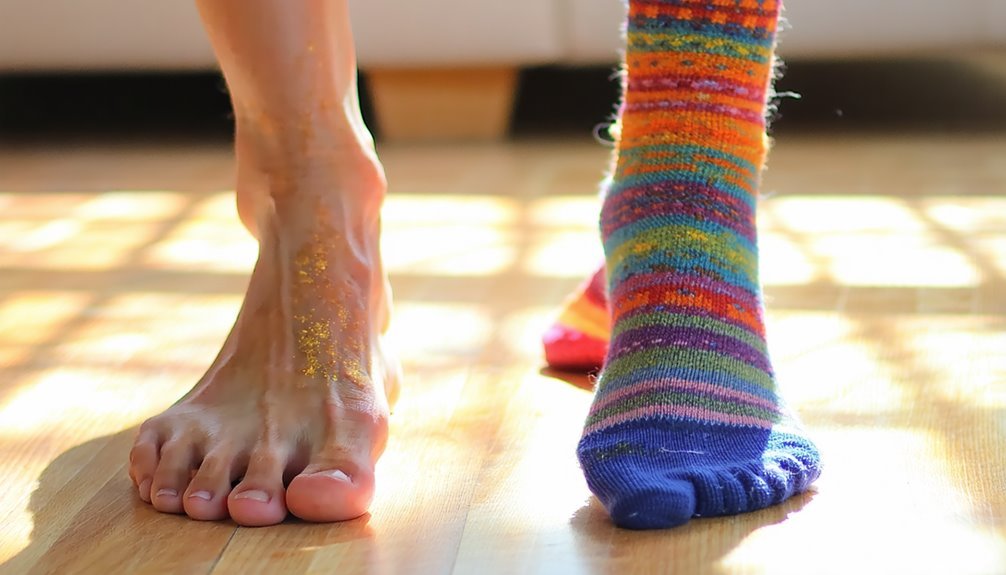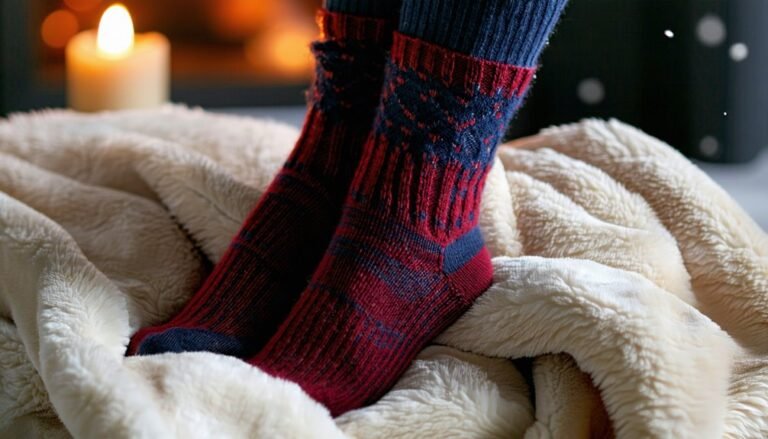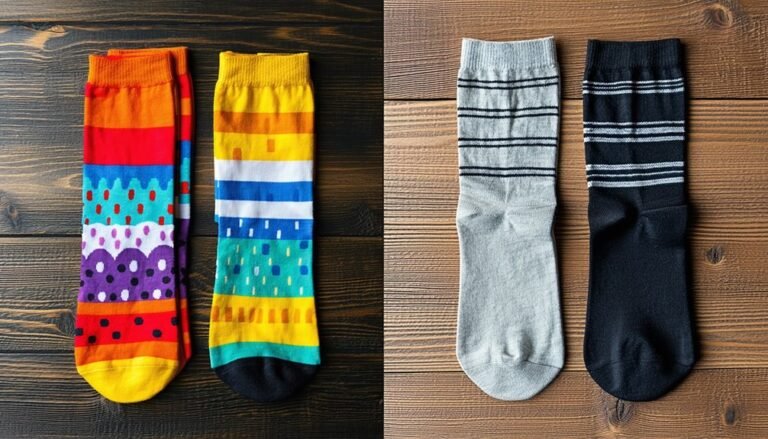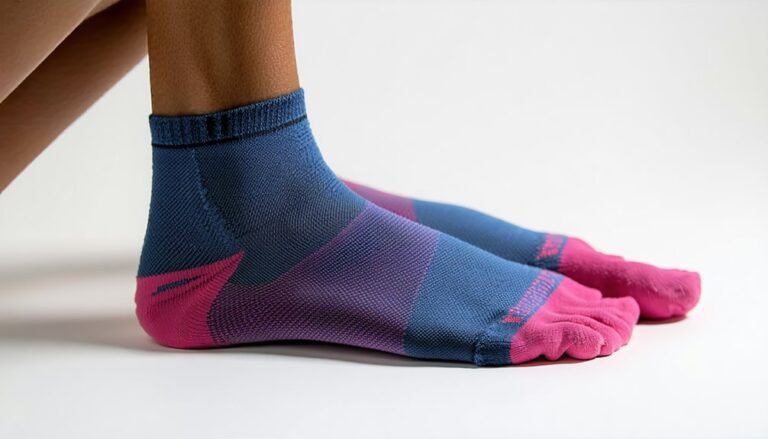Barefoot Vs Socks
Choosing between going barefoot or wearing socks involves biomechanical and hygiene considerations. Barefoot movement enhances proprioception and foot strength but increases injury and infection risks due to lack of protection. Socks provide thermal regulation, cushioning, and pathogen protection, thereby enhancing comfort and hygiene. Flooring surface and seasonal changes further influence this decision. Evaluating arch dynamics, environment, and personal foot health can guide ideal choices. Discover more about how these factors impact your foot health journey.
Understanding the Anatomy of the Foot
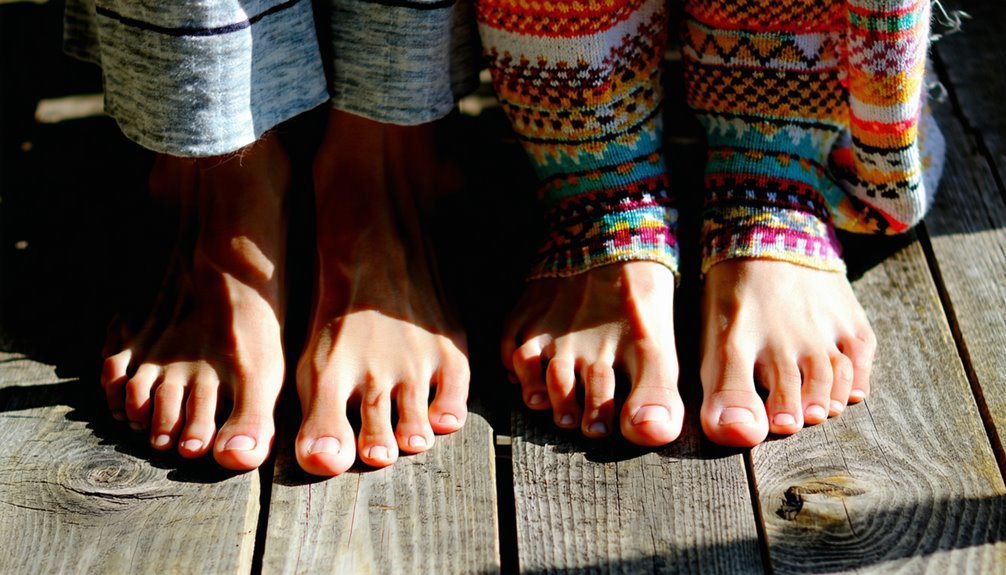
The human foot, a complex structure comprising 26 bones, 33 joints, and over 100 muscles, tendons, and ligaments, functions as a biomechanical marvel. Understanding this intricate foot structure is essential for ensuring safety and stability during ambulation. The foot's design accommodates various arch types: high (pes cavus), normal, and flat (pes planus), each influencing your body's biomechanics. High arches can lead to increased pressure on the metatarsal heads, while flat arches might cause overpronation, affecting gait. Proper evaluation of your foot structure and arch type can prevent potential injuries and enhance overall musculoskeletal health. Rely on evidence-based assessments to determine your specific foot needs, ensuring that the support provided aligns with your unique anatomical configuration for peak function and safety.
Health Benefits of Going Barefoot
Considering the foot's intricate anatomy and its role in biomechanics, exploring the practice of going barefoot reveals several health benefits. Enhanced proprioception is a primary barefoot benefit, as direct contact with the ground improves sensory feedback, aiding in balance and coordination. Furthermore, going barefoot can augment foot strength by engaging the intrinsic muscles often underutilized in shoes. This muscle activation contributes to improved foot arch stability and reduced risk of plantar fasciitis. Additionally, barefoot walking promotes natural gait patterns, leading to better body alignment and decreased joint stress. By allowing your feet to function naturally, you're also encouraging ideal neural pathways essential for foot health. Ultimately, embracing barefoot practices can offer substantial benefits without compromising safety, provided you exercise caution.
Potential Risks of Walking Without Socks
While walking without socks can offer certain advantages, it's important to recognize the potential risks associated with this practice. Exposure of the feet increases susceptibility to various issues, especially without the protective barrier that socks provide. Consider these potential risks:
- Foot injuries and friction burns: Without the cushioning effect of socks, you're more likely to encounter abrasions and pressure points, leading to discomfort and potential injury.
- Skin infections and fungal infections: Direct contact with surfaces increases the risk for microbial invasion, heightening the possibility of unpleasant skin conditions.
- Temperature regulation and circulation problems: Socks help insulate and maintain ideal blood flow, reducing vulnerability to cold and circulatory issues.
- Odor issues: Excessive sweat without socks can exacerbate odor, as moisture isn't wicked away effectively.
Prioritize foot health by considering these factors.
The Comfort and Warmth of Socks
When evaluating the benefits of wearing socks, one must consider how they enhance comfort and warmth through their insulating properties. Socks made from materials like merino wool and thermal blends provide ideal thermoregulation, maintaining a stable foot temperature. This is particularly important for individuals susceptible to cold-related pathologies, such as Raynaud's phenomenon. Different sock styles, including crew and knee-high, offer varying degrees of coverage, thereby influencing thermal retention.
Furthermore, the cushioning provided by certain sock materials reduces pressure points and friction, contributing to enhanced comfort. Evidence-based studies indicate that adequately cushioned socks can mitigate the risk of plantar fasciitis by distributing foot pressure evenly. By selecting appropriate socks, you can guarantee not only warmth but also a reduction in musculoskeletal stress, promoting overall foot health.
The Role of Socks in Foot Hygiene
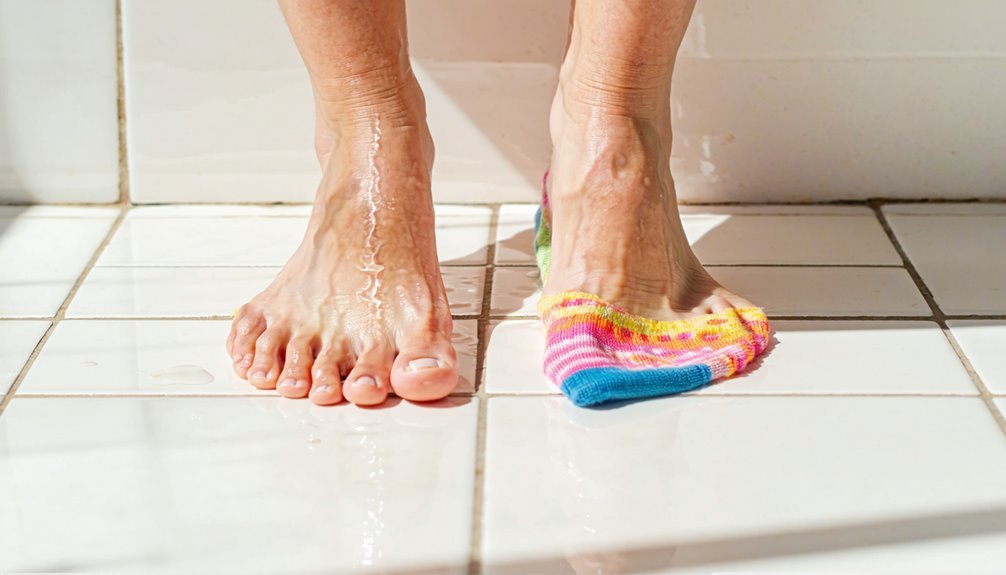
Socks play an essential role in maintaining ideal foot hygiene by acting as a barrier against pathogens and environmental contaminants. When you wear socks, you minimize direct contact with surfaces that could harbor harmful microorganisms. Consider these key benefits of socks hygiene:
- Moisture Management: Socks absorb sweat, reducing moisture that fosters microbial growth, thereby preventing foot odor.
- Friction Reduction: They reduce friction between your foot and footwear, preventing blisters and skin abrasions.
- Thermal Regulation: Socks help maintain a favorable temperature, reducing the risk of fungal infections like athlete's foot.
- Barrier Function: As a protective shield, they reduce the risk of infections by keeping dirt and bacteria at bay.
Cultural Perspectives on Barefoot Vs Sock Wearing
Although cultural norms considerably influence the preference for going barefoot or wearing socks, scientific evidence highlights distinct health implications associated with each practice. Different societies exhibit varying social perceptions regarding foot coverings. In many Western cultures, socks are deemed essential for maintaining foot hygiene, offering a barrier against microbial exposure and friction-induced dermal abrasions. Conversely, some Eastern cultures prioritize barefoot practices, emphasizing natural foot biomechanics and proprioceptive feedback, which may enhance balance and strength.
From a medical standpoint, wearing socks can prevent fungal infections, such as tinea pedis, by reducing moisture accumulation. Yet, prolonged sock use might impede skin ventilation, increasing the risk of hyperhidrosis. Understanding these cultural and health dynamics is vital for making informed, safe choices regarding foot attire.
The Impact of Flooring on Footwear Choices
When considering footwear choices, it's essential to evaluate the biomechanical implications of various flooring types. Hardwood floors may increase the risk of plantar stress due to their rigidity, making socks a protective option. Conversely, carpeted surfaces offer thermal insulation and shock absorption, while tile's low thermal conductivity can result in decreased peripheral circulation, suggesting potential benefits of wearing socks to maintain ideal foot temperature.
Hardwood Flooring Considerations
Have you ever contemplated the biomechanical implications of walking barefoot versus wearing socks on hardwood floors? Understanding these factors is essential for preventing injury and maintaining flooring integrity. Hardwood surfaces can be slippery, raising flooring safety concerns that impact your choice between barefoot and socks. Here's what to reflect on:
- Traction: Bare feet often provide better grip than socks, reducing fall risk on polished hardwood.
- Foot Health: Walking barefoot may promote natural foot biomechanics, enhancing proprioception and muscular engagement.
- Hardwood Maintenance Tips: Socks can prevent oils and sweat from direct contact, preserving floor finishes.
- Safety: Think about non-slip socks to balance safety and foot health, offering grip without sacrificing biomechanical benefits.
Your choices affect both safety and hardwood longevity.
Carpet Comfort and Warmth
While hardwood flooring poses its own set of challenges, carpeted surfaces offer a different dynamic when considering footwear choices. The plush carpet texture enhances foot relaxation, providing a cushioning effect that reduces stress on the plantar fascia, mitigating musculoskeletal strain. Carpeted environments can maintain thermal homeostasis, contributing to foot warmth, vital for peripheral circulation.
| Factor | Impact on Comfort |
|---|---|
| Carpet Texture | Enhances foot relaxation |
| Thermal Regulation | Maintains foot warmth |
| Musculoskeletal Support | Reduces strain on plantar fascia |
| Safety | Minimizes fall risk |
For those prioritizing safety, carpets provide a non-slip surface, minimizing fall risk, particularly for vulnerable populations. Opting for socks in carpeted areas can reduce friction, but make sure they're designed with anti-slip features. This selection optimizes comfort and maintains safety within domestic settings.
Tile and Cold Surfaces
Tile and cold surfaces present distinct challenges that considerably influence footwear choices. When traversing these environments, your decisions must prioritize both safety and comfort. Tile traction becomes paramount; evidence indicates that socks with grips enhance stability, reducing fall risk. Cold discomfort is another consideration; prolonged exposure to cold surfaces can lead to vasoconstriction and decreased peripheral perfusion, negatively impacting foot health. Here's a more in-depth examination:
- Tile Traction: Anti-slip socks minimize fall risk.
- Cold Discomfort: Insulating socks maintain thermoregulation.
- Foot Health: Barefoot exposure may exacerbate plantar fasciitis.
- Clinical Advice: Footwear selection should consider individual biomechanical factors.
Ultimately, understanding these elements helps you make informed choices that protect your health and safety on tile and cold surfaces.
Seasonal Considerations for Footwear
When considering seasonal footwear, you'll need to evaluate how temperature fluctuations influence thermoregulation and overall foot comfort. Material selection is critical, as certain fabrics offer better insulation or moisture-wicking properties, directly impacting foot health in varying weather conditions. Additionally, adapt your footwear to accommodate shifts in seasonal activities, which can alter biomechanical stress on the foot.
Temperature's Impact on Comfort
Understanding the impact of temperature on comfort is vital when considering seasonal footwear choices. Temperature regulation is important for maintaining ideal comfort levels and preventing adverse health effects. Here's how temperature influences your comfort and safety:
- Thermal Conductivity: Barefoot exposure may increase thermal loss, reducing comfort in cold environments. Socks offer insulation, enhancing warmth.
- Moisture Management: Excessive sweating, exacerbated by heat, can lead to dermatological conditions. Socks absorb moisture, promoting dermal health.
- Peripheral Circulation: Cold temperatures can constrict blood vessels, compromising circulation and potentially causing frostbite. Insulating socks can mitigate these risks.
- Neuropathy Considerations: Peripheral neuropathy increases susceptibility to temperature extremes. Socks provide protective cushioning, aiding in temperature perception.
Selecting appropriate footwear based on these factors guarantees your comfort and safety across varying seasonal conditions.
Material Choices for Weather
Although the choice of material in footwear is often overlooked, it's essential for adapting to seasonal weather changes. In cold climates, selecting weather materials such as wool or thermal synthetics can enhance insulation, reducing the risk of hypothermia. Wool, a natural fabric type, offers moisture-wicking capabilities, maintaining skin integrity by preventing dampness. Conversely, in warmer weather, breathable fabrics like cotton or technical mesh are advisable. These materials facilitate airflow, minimizing hyperhidrosis and fungal infections, common in high humidity. Furthermore, ultraviolet (UV) resistant textiles can protect against solar radiation, reducing the risk of skin cancer. When choosing fabric types, prioritize those that align with your environmental exposure and health requirements, ensuring a safe and adaptive approach to seasonal footwear.
Seasonal Activity Adjustments
Seasonal changes necessitate adapting footwear to align with varying activity levels and environmental conditions. During colder months, thermal insulation is essential to prevent vasoconstriction and frostbite risk. Conversely, warmer seasons demand breathability to avoid hyperhidrosis and fungal infections. When engaging in outdoor activities, consider the following seasonal trends:
- Winter: Opt for moisture-wicking socks and insulated footwear to maintain thermoregulation and prevent hypothermia.
- Spring: Shift to lightweight, breathable materials to accommodate increased activity and avoid dermatitis.
- Summer: Prioritize ventilation and UV protection to reduce the risk of heat-related illnesses and photodamage.
- Fall: Reinforce foot support for stability on uneven terrain, minimizing the likelihood of musculoskeletal injuries.
The Science Behind Foot Sensitivity
When examining foot sensitivity, the intricate network of nerve endings plays a vital role. Your feet contain approximately 200,000 nerve endings, capable of receiving detailed sensory feedback. This feedback helps you maintain balance and detect variations in terrain, temperature, and pressure. It's essential for ensuring foot safety and preventing injury, as your nervous system rapidly processes these signals to adjust your posture and gait accordingly.
The concentration of foot nerve endings means any external pressure or stimuli is swiftly communicated to your brain. Wearing socks can slightly dampen this sensory input, providing a layer of protection while maintaining some level of tactile awareness. Understanding this balance is important for making informed decisions about whether to go barefoot or wear socks, ensuring both comfort and safety.
Personal Preferences and Lifestyle Factors
Personal preferences and lifestyle factors greatly influence the choice between going barefoot or wearing socks. Your comfort preferences, daily activities, and environment considerably determine this decision. Consider the following factors:
- Thermoregulation Needs: If you live in colder climates, socks provide necessary insulation and prevent hypothermia.
- Dermatological Conditions: For individuals with skin sensitivities, socks offer a protective barrier against allergens and irritants.
- Biomechanical Support: Those engaging in high-impact activities may benefit from socks that provide cushioning and arch support.
- Hygienic Considerations: Socks can absorb sweat, reducing the risk of fungal infections like athlete's foot.
Frequently Asked Questions
How Does Barefoot Vs Sock Wearing Affect Athletic Performance?
You're curious about how foot biomechanics influence athletic performance. Evidence suggests barefoot training enhances proprioception and balance training, promoting improved stability. However, wearing socks might offer protection, reducing injury risk. Consider individual needs for ideal athletic outcomes.
Are There Specific Sports That Favor Barefoot Over Socks?
In beach volleyball, barefoot playing enhances proprioception and balance on sand, reducing injury risk. Martial arts often favor barefoot practice to improve grip and prevent slipping, promoting safety through increased tactile feedback and joint stability.
Do Socks Influence Foot Odor More Than Bare Feet?
Socks can influence foot odor more than bare feet due to their capacity for sweat absorption, which fosters bacterial growth. This environment increases odor production, so selecting moisture-wicking socks can mitigate this issue, enhancing comfort and safety.
How Do Barefoot and Sock Choices Affect Shoe Fit?
Your shoe comfort and fit adjustments depend on whether you wear socks. Socks can provide cushioning and reduce friction, promoting a safer fit. Conversely, barefoot conditions may require careful sizing to prevent injury or improper alignment.
What Are the Psychological Effects of Being Barefoot Vs Wearing Socks?
You might experience increased foot freedom and enhanced sensory connection when barefoot, which can promote relaxation. Conversely, wearing socks may offer psychological comfort and a perception of safety, reducing anxiety by providing a protective barrier.

